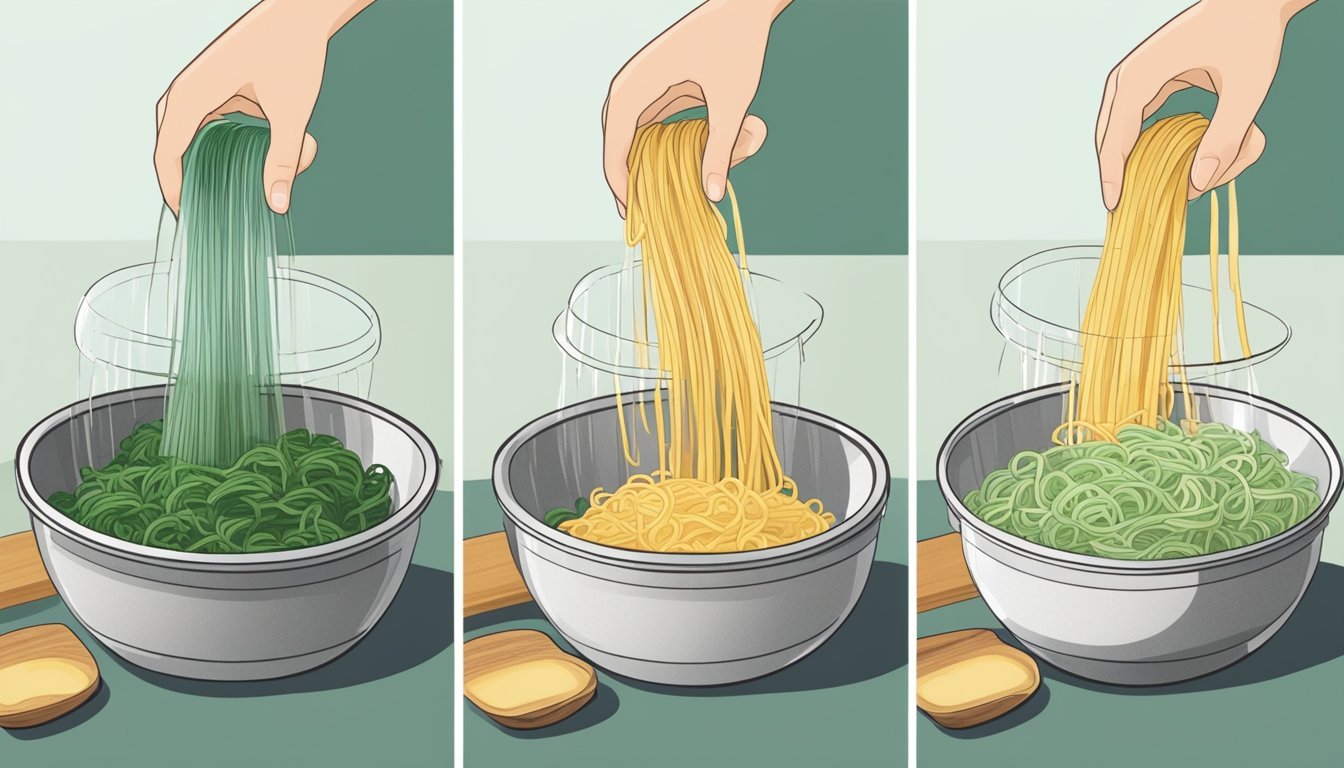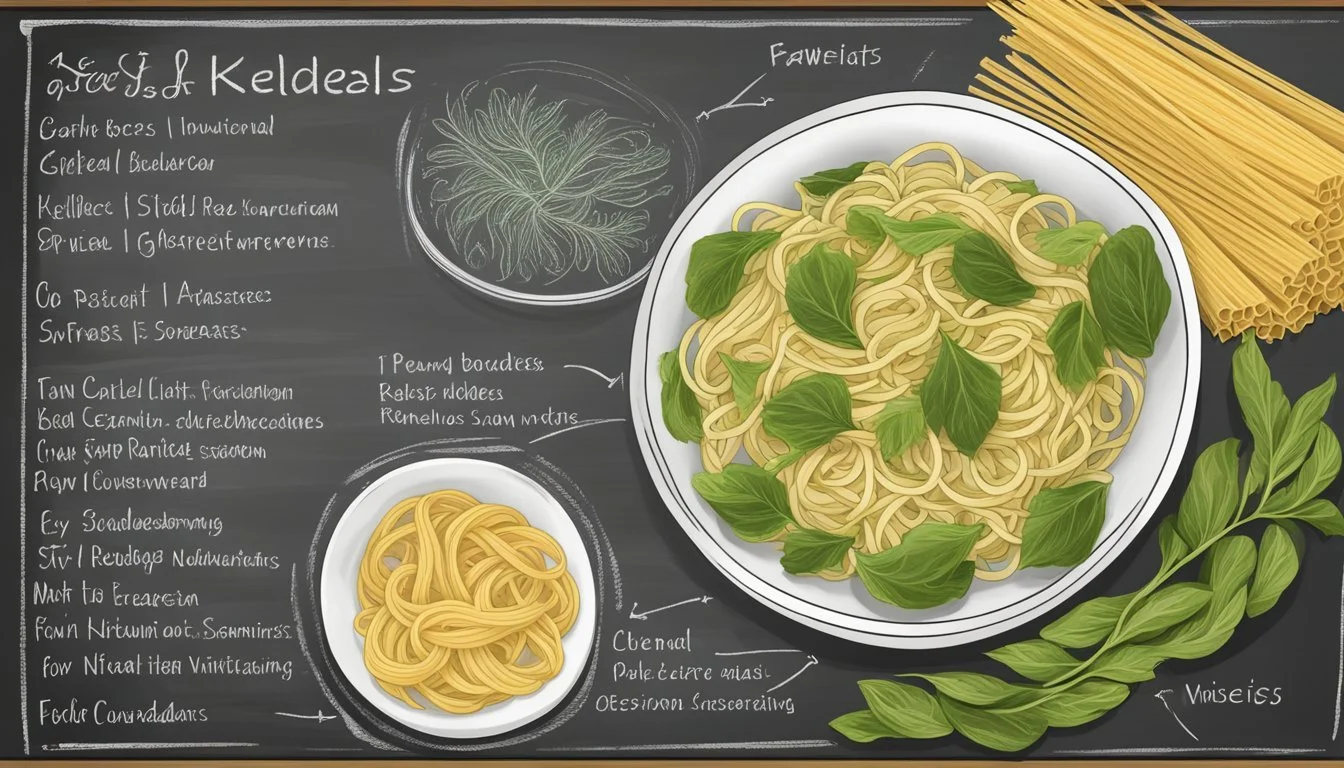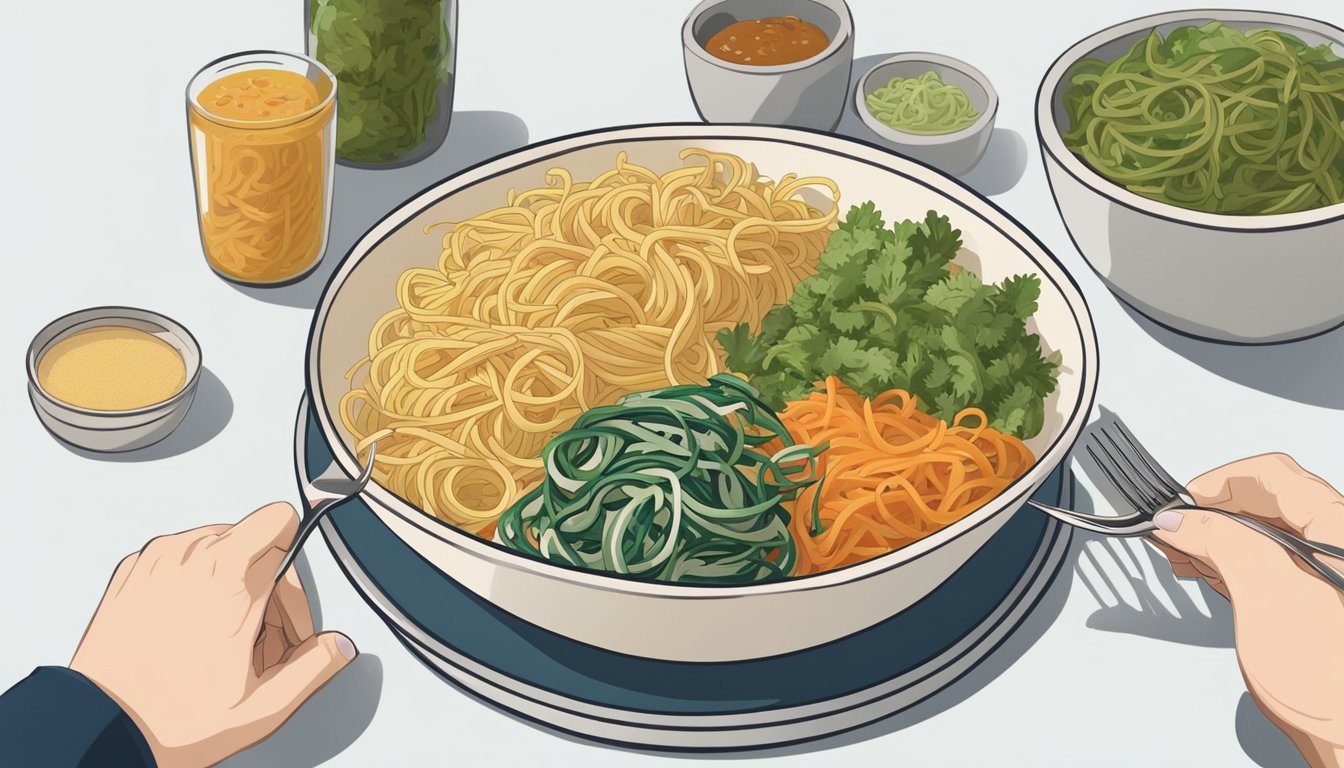How to Substitute Kelp Noodles for Pasta
A Simple Guide for Healthier Meals
Kelp noodles are a unique and nutritious alternative to traditional pasta, offering a low-calorie and gluten-free option for those seeking to maintain a healthy lifestyle. Made from the brown seaweed that gives them their name, these noodles are transparent, gelatinous, and have a slightly crunchy texture. They are versatile in the kitchen and can be used in a wide array of dishes, ranging from salads to soups, and stir-fries to main courses.
Substituting kelp noodles for pasta (What wine goes well with pasta?) is an excellent way to add a boost of minerals and vitamins to any meal. Kelp is a natural source of iodine, which is essential for thyroid function, as well as containing a variety of other nutrients. Their neutral flavor allows them to easily absorb the tastes of sauces and seasonings, making them a seamless addition to recipes typically reserved for traditional wheat pasta.
Transitioning to kelp noodles from regular pasta can be a simple process. These noodles do not require extensive cooking, thus saving time in meal preparation – a brief rinse and a soak, or a few minutes in boiling water, can be enough to prepare kelp noodles for most dishes. Their texture varies from crispy to soft depending on preparation methods, which can be adjusted according to personal preference and the specific requirements of the recipe at hand.
Understanding Kelp Noodles
Kelp noodles are a sea-based alternative to traditional pasta, made primarily from three ingredients: edible brown seaweed, water, and sometimes a natural mineral called sodium alginate derived from the seaweed itself. They are known for their unique, crunchy texture and are a versatile ingredient that can complement a variety of dishes.
Nutritional Profile: Kelp noodles boast a rich supply of minerals such as iodine and calcium, essential for thyroid function and bone health respectively. They are also a source of vitamins and are high in fiber. Due to their seaweed origin, they carry additional nutrients not commonly found in land vegetables.
Dietary Benefits: These noodles are a boon for many dietary preferences. They are low-carb, gluten-free, and low-calorie, making them suitable for individuals following specific dietary regimes. Unlike traditional pasta which is rich in carbohydrates, kelp noodles contain a minimal amount making them favorable for a low-carb diet.
Shelf Life and Preparation: People often choose kelp noodles for their long shelf life and ease of preparation. They do not require extensive cooking; a simple rinse in water is often enough. To achieve a softer texture similar to that of traditional pasta, they can be soaked or briefly boiled.
Originally from Asia, particularly Korea, kelp noodles have gained popularity globally as a healthful substitute for pasta. They are a refreshing twist in the culinary world, providing a crunch when raw and a tender bite when properly prepared.
Culinary Uses: In addition to being a pasta substitute, they can be incorporated into salads, soups, and stir-fries, providing a neutral palette that absorbs the flavors they are mixed with. From an environmental standpoint, they are a sustainable food source, as seaweed cultivation has a low ecological footprint.
Remember, while kelp noodles can be an excellent addition to various diets, it's important to factor in individual iodine and sodium levels to ensure dietary balance.
Nutritional Benefits and Considerations
When considering kelp noodles as a pasta substitute, it's essential to understand their nutrition profile, how they compare to traditional pasta, and their impact on various dietary needs.
Comparison of Carbs and Calories
Kelp noodles boast a significantly lower carbohydrate and calorie content compared to traditional pasta. While a typical serving of regular pasta contains about 200 calories and 40 grams of carbohydrates, a similar amount of kelp noodles may contain as little as 20 calories and zero net carbs. This stark difference makes kelp noodles an attractive option for low-carb and low-calorie diets.
Protein and Mineral Content
Kelp noodles are not a significant source of protein, which is a contrast to some forms of traditional pasta that may have up to 8 grams per serving. However, they are a rich source of certain minerals, notably iodine, which is critical for thyroid function, along with potentially trace amounts of calcium, iron, and manganese.
Gluten-Free and Allergy Information
For individuals with celiac disease or gluten sensitivity, kelp noodles serve as a gluten-free alternative to pasta made from wheat flour. They are also a potential option for those with allergies related to grains, as they are derived from sea tangle—a type of seaweed.
Impact on Blood Sugar and Diet
Due to their minimal carbohydrate content, kelp noodles have a negligible impact on blood sugar levels, making them suitable for diabetic diets or those following ketogenic or paleo plans that limit carb intake.
Hydration and Sodium Content
Kelp noodles have a high water content but can also be high in sodium, which can contribute to water retention. Consumers should balance their sodium intake with their hydration needs, especially if they are managing conditions that require sodium restriction.
Weight Management and Satiety
The low calorie and carb content of kelp noodles can aid in weight management. However, because they are low in fiber and protein, which contribute to feelings of fullness, they might be less satisfying than other pasta alternatives. Pairing kelp noodles with protein and fiber-rich foods can help increase satiety.
In summary, kelp noodles present a low-calorie, low-carb pasta alternative with unique mineral benefits, suited for a range of dietary preferences and needs. However, protein pairing and monitoring of sodium intake is advisable.
Substituting Kelp Noodles for Traditional Pasta
Kelp noodles are a versatile, low-carb alternative to traditional pasta, boasting a unique texture and the ability to absorb flavors well. They can be seamlessly incorporated into various dishes with a few simple adjustments and preparation techniques.
Texture and Flavor Adaptations
Kelp noodles have a distinct texture; they are crunchy when raw but become more tender when cooked. Their flavor is neutral, making them an excellent base for absorbing the aromas and tastes of sauces and seasonings. To mimic the al dente texture of traditional pasta, avoid overcooking kelp noodles as they can quickly become too soft.
Proper Preparation and Cooking Techniques
To prepare kelp noodles, rinse them thoroughly in cold water. Then, if desired, simmer them in lightly salted water for 5-10 minutes to achieve a more pasta-like texture. Immediately rinsing the noodles under cold water after cooking will halt the cooking process and maintain their desired consistency.
Matching Kelp Noodles with Various Sauces and Dishes
Kelp noodles pair well with an array of sauces and dishes—from a simple marinara to a rich pesto or even a tangy vinaigrette in a salad. Their neutral taste ensures compatibility with the full spectrum of pasta dishes, including stir-fries and soups.
Creative Alternatives and Recipe Ideas
Consider recipe variations like substituting kelp noodles in a classic spaghetti squash dish or as a base for a low-carb lasagna. Both options highlight the noodles' versatility and enhance the nutritional profile of your meals with added minerals from the seaweed.
Portion Sizes and Presentation Tips
When serving kelp noodles, aim for similar portion sizes to traditional pasta to ensure a satisfying meal. Present them well-drained and at the appropriate temperature to enhance the dish's appeal; for example, chilled for salads or steaming for hot pasta alternatives.
Making Homemade Kelp Noodles
Creating homemade kelp noodles can be an adventurous kitchen experiment, involving kelp powder mixed with water and salt. However, it requires precise measurements and patience to ensure the right consistency and flavor.
Storage and Shelf Life
Kelp noodles have a remarkable shelf life when kept in water and properly refrigerated. To maximize their storage potential, ensure the water is changed every few days, and keep them tightly sealed in a container to maintain freshness.
Health Considerations and Dietary Choices
Substituting traditional pasta with kelp noodles can cater to various dietary restrictions and health considerations. This section will evaluate the suitability of kelp noodles for low-carb diets, their nutritional benefits, as well as their potential for those with specific health concerns and dietary needs.
Role in Low-Carb and Ketogenic Diets
Kelp noodles are an excellent option for those following a low-carb or ketogenic diet. They have a minimal amount of digestible carbohydrates and are essentially keto-friendly. By incorporating kelp noodles into meals, individuals can significantly reduce their overall carb intake, supporting the maintenance of ketosis which is the cornerstone of the ketogenic diet.
Enhancing Nutritional Value in Meals
These noodles are not only low in carbs but also gluten-free, making them a safe alternative for individuals with celiac disease or gluten sensitivity. They also contribute essential minerals and vitamins to one's diet, enriching meals with additional nutrition. However, they are low in protein and fiber, thus it may be important to supplement them with other protein and fiber-rich foods to balance the meal.
Addressing Specific Health Concerns
Incorporating kelp noodles into a diet can be beneficial for individuals with diabetes as they have a negligible effect on blood sugar levels due to their low glycemic index. Additionally, they are a convenient option for those with certain food allergies, as they are free from common allergens found in traditional pasta, like wheat.
Understanding the Glycemic Index
Kelp noodles have a very low glycemic index (GI), which means they have a minimal impact on blood sugar levels compared to high-GI foods. This makes them an appropriate choice for managing diabetes and for those looking to moderate their blood sugar response through their diet.
Market and Sustainability
When considering kelp noodles as a pasta substitute, it's crucial to assess not only their culinary versatility but also their place in the market and their sustainability credentials compared to other pasta alternatives.
Comparing to Other Pasta Alternatives
Kelp noodles distinguish themselves from other popular pasta alternatives such as bean pasta (which includes black bean, chickpea, and lentil pasta), rice noodles, and spiralized vegetables by offering a distinctly low-carbohydrate and nutrient-rich option. While spiralized vegetables like zucchini provide a similar low-carb appeal, kelp noodles have a unique texture that closely mimics traditional pasta.
Bean pastas: High in protein and fiber
Rice and soba noodles: Derived from grains; gluten-free options
Kelp noodles: Low-calorie, mineral-rich, gluten-free, and paleo-friendly
Spiralized vegetables: Low in calories but vary in nutrient content
Shirataki (konjac) noodles: Low-calorie, made from the konjac root
Environmental Impact and Sustainability
Kelp noodles carry a lower environmental footprint, promoting sustainability in several ways. Firstly, kelp farming does not require arable land, fertilizer, or fresh water, conserving valuable environmental resources. What's more, kelp's role in absorbing carbon dioxide and supporting marine biodiversity underscores its environmental benefits.
Key sustainability points for kelp as a raw material:
No need for freshwater or pesticides
Helps in ocean carbon sequestration
Strengthens marine ecosystems
Understanding the Global Market of Kelp Products
The global market for kelp products is pluralistic, with Asia, and Korea in particular, playing a pivotal role as a major producer. The rise of kelp noodles as a health food option mirrors a growing consumer trend towards sustainable and health-conscious eating. With an increase in their availability in both specialty markets and mainstream supermarkets, kelp noodles are becoming accessible worldwide.
Market dynamics:
Asia: Principle region for kelp production
Health-conscious consumers drive demand
Kelp noodles are positioned in the market as a sustainability-forward alternative appealing to not only those looking for health food options but also individuals concerned with the environment. As they become more prevalent on the shelves of stores from 99 Ranch Market to H Mart, the consumer's access to these sustainable choices expands, solidifying the presence of kelp noodles in the global market.
Shopping Guide for Kelp Noodles
When considering kelp noodles as a pasta substitute, shoppers should bear in mind several key attributes. Kelp noodles are known for their unique texture and health benefits. They are gluten-free, making them an excellent choice for those with gluten sensitivities or celiac disease.
Where to Buy: Kelp noodles can usually be found in health food stores, Asian supermarkets, or online. They are typically located in the gluten-free or health-conscious sections.
Reading Labels: It is important to read the label carefully to ensure product quality. Buyers should look for:
Ingredients: Pure kelp noodles should contain only kelp, water, and sometimes a natural mineral called sodium alginate.
Nutritional Information: Check for sodium content, as kelp noodles can be high in sodium.
Organic Certification: While not mandatory, organic kelp noodles assure avoidance of synthetic fertilizers and pesticides.
Health Benefits: One of the benefits of kelp noodles is their iodine content, which is naturally present in kelp. Iodine is crucial for thyroid function. Additionally, they offer a good source of calcium.
Selection Tips:
Select noodles that are clear and have a neutral smell.
Avoid any packages that show signs of discoloration or damage.
Storage: Kelp noodles have a long shelf life and should be stored in a cool, dry place. Refrigeration is not necessary until the package is opened.
By choosing kelp noodles, shoppers can enjoy a nutritious, low-calorie pasta alternative that complements a variety of dishes. Remember to enjoy them in moderation due to their iodine content.
Frequently Asked Questions
Q: How do kelp noodles compare nutritionally to regular pasta?
A: Kelp noodles are low in calories and carbs but high in fiber, making them suitable for ketogenic diets. Unlike typical pasta, they are gluten-free. They have a naturally salty taste due to their high sodium content.
Q: What texture do kelp noodles have?
A: These noodles have a slightly crunchy texture which softens with cooking. For a texture closer to traditional pasta, soak or cook kelp noodles as per the package instructions.
Q: Can people with gluten intolerance consume kelp noodles?
A: Yes, kelp noodles are gluten-free, making them an excellent pasta substitute for those with gluten sensitivities or celiac disease.
Q: Are kelp noodles suitable for Asian dishes?
A: Yes, kelp noodles originate from Asia and can easily be incorporated into Asian cuisine, especially in dishes that typically use glass or rice noodles.
Q: How do kelp noodles affect blood sugar levels?
A: Due to their minimal impact on blood sugar levels, kelp noodles are a good choice for individuals looking to manage their blood sugar levels.
Q: What is the shelf life of kelp noodles, and how should they be stored?
A: They have a long shelf life compared to traditional pasta. Store them in a cool, dry place, and always check the label for specific expiration dates and storage recommendations.
Nutritional Breakdown Table
Nutrient Kelp Noodles Regular Pasta Calories Low High Carbs Low High Fiber High Varies Gluten-free Yes No Sodium High Low
For the most accurate and current nutritional information, consumers should consult the product label of the specific brand of kelp noodles they purchase.
Conclusion
Kelp noodles are a versatile pasta alternative that cater to those seeking a low-carb, gluten-free option. They offer distinct nutritional benefits, such as being rich in minerals like iodine and calcium. When incorporating kelp noodles into meals, a few simple cooking tips can enhance their texture and flavor compatibility with other ingredients.
To prepare kelp noodles, it is suggested to rinse them thoroughly and then blanch them briefly. This can help to soften the noodles, making them more palatable. For further softening, marinate the noodles in lemon juice or a sauce of choice before adding them to your dish.
Regarding their nutritional profile, kelp noodles are quite low in calories. They also contribute to fiber intake, though they are not as high in protein as traditional pasta. This lacking nutrient can be compensated by pairing with protein-rich foods such as meats, legumes, or dairy products.
Kelp Noodles Traditional Pasta Low in calories Higher in calories Gluten-free Contains gluten Mineral-rich Varies by type Requires brief cooking Requires longer cooking
Lastly, the neutral taste of kelp noodles allows them to take on the flavors of the sauces and seasonings used in the dish. To maximize enjoyment, individuals are encouraged to experiment with various sauces and additional ingredients to find the combination that best suits their taste preferences. Through exploration, one may find that kelp noodles are not only a satisfactory substitute but also a delightful culinary discovery in their own right.







